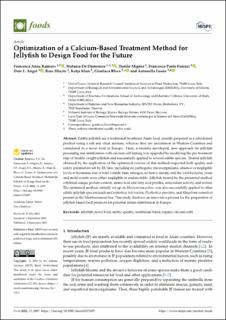| dc.contributor.author | Ramires, Francesca Anna | |
| dc.contributor.author | De Domenico, Stefania | |
| dc.contributor.author | Migoni, Danilo | |
| dc.contributor.author | Fanizzi, Francesco Paolo | |
| dc.contributor.author | Angel, Dror L. | |
| dc.contributor.author | Slizyte, Rasa | |
| dc.contributor.author | Klun, Katja | |
| dc.contributor.author | Bleve, Gianluca | |
| dc.contributor.author | Leone, Antonella | |
| dc.date.accessioned | 2023-01-12T11:28:08Z | |
| dc.date.available | 2023-01-12T11:28:08Z | |
| dc.date.created | 2022-10-05T13:40:44Z | |
| dc.date.issued | 2022 | |
| dc.identifier.citation | Foods. 2022, 11 (17), 1-20. | en_US |
| dc.identifier.issn | 2304-8158 | |
| dc.identifier.uri | https://hdl.handle.net/11250/3042989 | |
| dc.description.abstract | Edible jellyfish are a traditional Southeast Asian food, usually prepared as a rehydrated product using a salt and alum mixture, whereas they are uncommon in Western Countries and considered as a novel food in Europe. Here, a recently developed, new approach for jellyfish processing and stabilization with calcium salt brining was upgraded by modifying the pre-treatment step of freshly caught jellyfish and successfully applied to several edible species. Treated jellyfish obtained by the application of the optimized version of this method respected both quality and safety parameters set by EU law, including no pathogenic microorganisms, absence or negligible levels of histamine and of total volatile basic nitrogen, no heavy metals; and the total bacterial, yeast, and mold counts were either negligible or undetectable. Jellyfish treated by the presented method exhibited unique protein content, amino acid and fatty acid profiles, antioxidant activity, and texture. The optimized method, initially set up on Rhiszostoma pulmo, was also successfully applied to other edible jellyfish species (such as Cotylorhiza tuberculata, Phyllorhiza punctata, and Rhopilema nomadica) present in the Mediterranean Sea. This study discloses an innovative process for the preparation of jellyfish-based food products for potential future distribution in Europe. | en_US |
| dc.language.iso | eng | en_US |
| dc.publisher | MDPI | en_US |
| dc.rights | Navngivelse 4.0 Internasjonal | * |
| dc.rights.uri | http://creativecommons.org/licenses/by/4.0/deed.no | * |
| dc.subject | organic calcium salts | en_US |
| dc.subject | nutritional traits | en_US |
| dc.subject | quality | en_US |
| dc.subject | safety | en_US |
| dc.subject | novel food | en_US |
| dc.subject | jellyfish | en_US |
| dc.title | Optimization of a Calcium-Based Treatment Method for Jellyfish to Design Food for the Future | en_US |
| dc.title.alternative | Optimization of a Calcium-Based Treatment Method for Jellyfish to Design Food for the Future | en_US |
| dc.type | Peer reviewed | en_US |
| dc.type | Journal article | en_US |
| dc.description.version | publishedVersion | en_US |
| dc.rights.holder | Copyright: © 2022 by the authors. Licensee MDPI, Basel, Switzerland. This article is an open access article distributed under the terms and conditions of the Creative Commons Attribution (CC BY) license (https:// creativecommons.org/licenses/by/ 4.0/). | en_US |
| dc.source.pagenumber | 1-20 | en_US |
| dc.source.volume | 11 | en_US |
| dc.source.journal | Foods | en_US |
| dc.source.issue | 17 | en_US |
| dc.identifier.doi | 10.3390/foods11172697 | |
| dc.identifier.cristin | 2058806 | |
| cristin.ispublished | true | |
| cristin.fulltext | original | |
| cristin.qualitycode | 1 | |

